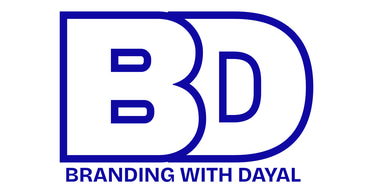Building a Personal Brand That Lasts: Beyond the Social Media Hacks
Dayal Punjabi
10/28/20259 min read


Let’s cut through the noise and look at what it truly takes to build a successful personal brand. And let me be clear from the start: most people are getting personal branding completely wrong.
If you ask someone about personal branding, they'll immediately talk about LinkedIn growth tactics, content hooks, viral hacks, and social media "playbooks." They'll share the latest algorithm tricks or tell you to comment 10 times a day for maximum engagement. But here's the truth that the growth gurus won't tell you: great personal branding starts offline, by understanding who you are, what you stand for, and what you want to achieve.
The strategy behind building an authentic personal brand has nothing to do with chasing vanity metrics and everything to do with building genuine influence and thought leadership that creates real opportunities. Let's break down the six key principles that will transform how you approach personal branding, principles that have helped countless professionals move from invisible to influential.
Key Takeaways
Great personal branding starts offline, it’s about who you are, what you stand for, and what you want to achieve.
Your personal brand is your reputation and unique identity, not your social media presence.
Always begin with clear, specific goals for your personal brand to guide your strategy.
Be ruthlessly selective: share only what’s relevant to your core objectives.
Build visible credibility with social proof, mixing broad and niche audiences for lasting influence.
Personal Brand ≠ Social Media
This is perhaps the most critical misconception in the personal branding world. Your personal brand is not your online presence, it's your reputation, your story, the trust people have in you, and your unique identity. Social media platforms like LinkedIn simply distribute what already exists within you.
Think about it this way: before the internet existed, people still had personal brands. Your personal brand is what people say about you when you're not in the room. It's the expertise you've demonstrated, the problems you've solved, the relationships you've built, and the values you've consistently shown up with. Social media is just the amplifier, not the source.
According to recent research, 54% of employers have rejected candidates due to poor personal branding on social media profiles, which proves that your online presence matters, but only when it authentically reflects who you truly are. The platform doesn't create your personal brand; it reveals it.
Don't get lost chasing tactics like growth hacks or engagement pods. Start building from the inside out. Define who you are first, then let the platforms showcase that identity to the world.
Always Begin with Why: The Foundation of Personal Brand Strategy
Never post just because everyone else is doing it. This is where most personal branding efforts fall apart before they even begin. People jump onto LinkedIn or other platforms without a clear strategy, creating content for content's sake, and then wonder why nothing meaningful happens.
Start by being crystal clear on your goals. Ask yourself:
Are you here to generate business leads?
Build credibility in your industry?
Create a broader impact through thought leadership?
Position yourself for speaking opportunities?
Attract talent to your organization?
Each of these objectives requires a different approach and content strategy.
Research from LinkedIn and Edelman shows that 52% of decision-makers and 54% of C-suite executives spend an hour or more each week reading thought leadership content, which means there's a hungry audience out there, but they're looking for substance, not surface-level engagement tactics.
Before you ever hit record on a video or publish your first post, write down 3-4 core objectives for your personal brand. Be specific. "Build my personal brand" is not an objective, it's a vague aspiration. "Generate three qualified leads per month from LinkedIn" or "Establish myself as a go-to expert on sustainable business practices to secure two speaking engagements this year," now those are objectives you can build a strategy around.
Your personal brand strategy should be as thoughtful as any business strategy. Without clarity on your "why," you'll chase every trend, exhaust yourself with constant posting, and ultimately build nothing of lasting value.
Know Yourself, and Get Ruthless About Relevance
Building a personal brand requires deep self-awareness combined with strategic selectivity. This is where the real work happens, and it's uncomfortable for many people.
Start with a comprehensive audit of everything about yourself, your professional experience, your unique perspectives, your values, your strengths, even your quirks and personality traits. Write it all down. What problems have you solved? What insights have you gained? What makes your approach different? What do people consistently come to you for advice about?
But here's where most people make their second critical mistake: they try to showcase everything. They post about their morning routine, their favorite sports team, their hobby collections, and their professional expertise all mixed together. While authenticity matters, relevance matters more.
Once you've done your self-audit, get ruthlessly selective. Only share those elements that truly support your stated objectives. For instance, being a Manchester City fan might be a big part of your life, but if it won't help your personal brand as a B2B technology leader, leave it out. Your personal brand isn't about hiding who you are, it's about strategically emphasizing the aspects of yourself that serve your goals.
This doesn't mean being inauthentic. It means being intentional. Every piece of content, every story you share, every interaction should ladder up to your core objectives and reinforce the thought leadership position you're building.
Engineer Social Proof and Validation
Personal branding is about both: audience size & building visible, verifiable credibility. This is what separates influential thought leaders from people with large followings who can't convert that attention into real opportunities.
Social proof comes in many forms: speaking engagements at industry conferences, bylines in respected publications, awards and recognitions, testimonials from clients or colleagues, follower milestones that demonstrate reach, partnerships with established brands, or being quoted as an expert in media outlets.
Map out what I call a "ladder of influence": a step-by-step progression that takes you from where you are now toward your industry goals. Each rung builds trust and opens doors to the next level. For example:
Guest on industry podcasts
Contribute articles to industry publications
Speak at local professional events
Speak at regional conferences
Keynote at national events
Published author or recognized industry voice
The key is that each achievement becomes a credential for the next. Your LinkedIn profile is more than a resume, a portfolio of proof that validates your thought leadership and expertise.
Mix Broad and Niche Audiences: The Dual Strategy
Here's a strategic principle that many personal branding experts miss: you need both broad and niche audiences, and you need to serve them with different types of content.
Your broad audience provides volume and visibility. These are people who may never become clients or direct opportunities, but they expand your reach, share your content, and create the network effects that make thought leadership work. They're the reason your posts get seen by people outside your immediate network.
Your niche audience, on the other hand, is your money audience, the people who can actually buy, refer business, open career opportunities, or make meaningful introductions. They're the decision-makers, the peers at your level, the connectors who matter to your specific goals.
Research shows that 88% of customers place importance on authenticity in branding efforts, which means both audiences are watching to see if you're genuine or just performing for attention.
The smartest personal branding strategy creates content that scales across both audiences. Share insights that are accessible enough for the broad audience to engage with, but deep enough that your niche audience sees real value. Talk about universal professional challenges, but bring your specific expertise to the solutions.
Don't limit yourself to just building a niche following because you're afraid of diluting your message. And don't only chase broad viral content that attracts the wrong audience. Build deliberately across both dimensions.
Consistency and Curiosity Trump Hacks
Let's talk about what actually creates breakthrough thought leadership versus what the "LinkedIn growth" crowd will tell you.
The growth hackers will tell you to comment on 20 posts per day, use specific posting times, leverage certain hooks, join engagement pods, and follow rigid content formulas. Some of these tactics might generate short-term metrics, but they rarely build lasting influence or genuine thought leadership.
Real leaders and innovators break through not because they mastered the algorithm, but because they're consistently curious, share their lessons honestly, and show up with unique insights that only they can provide. They're not regurgitating generic advice, they're synthesizing their experiences into perspectives that help others see things differently.
Thought leadership is about having something worth saying and saying it consistently enough that people come to rely on your voice. It's about being in conversations, not just broadcasting campaigns. It's about engaging with ideas, challenging assumptions respectfully, and adding nuance to important debates in your industry.
The best support system for your personal brand won't script your words or give you 30 content templates. They'll help you reflect on your unique experiences, create frameworks that capture your insights, and show up as your real self: both online and offline.
This is where personal branding transcends LinkedIn tactics and becomes genuine thought leadership. You stop performing and start contributing. You stop optimizing for engagement and start optimizing for impact.
Your Action Plan: From Strategy to Execution
Now that you understand the principles, here's how to put them into action:
Step 1: Map Your Objectives:
Take one hour this week to write down why you're actually building a personal brand. What specific outcomes do you want? Be honest and be concrete. If you can't articulate clear objectives, you're not ready to create content yet.
Step 2: Conduct Your Personal Audit:
Audit your strengths, stories, experiences, and values. Write down everything, then circle only the ones that align with your stated goals. This is your content goldmine, the authentic material that will fuel your thought leadership.
Step 3: Identify Your Credibility Milestones:
Choose two specific credibility milestones you can work toward in the next 6-12 months. This might be securing a speaking engagement, publishing a guest article in an industry publication, or building a following in a specific niche on LinkedIn. Make them specific and achievable.
Step 4: Build Your Content Strategy:
Based on your objectives and your personal audit, create a simple content strategy. What topics will you focus on? What unique perspective can you bring? How will you serve both your broad and niche audiences?
Step 5: Show Up Consistently:
Commit to a sustainable posting rhythm. Whether that's twice a week or daily, consistency matters more than frequency. Remember: viral content is a byproduct of consistently valuable content, not a starting point.
Building a Brand That Lasts
Personal branding done right is not about gaming LinkedIn algorithms or chasing viral moments. It's about building a reputation for expertise, trustworthiness, and unique insight that creates real opportunities over time.
Step back from "hack culture" and start building a personal brand that's as strong offline as it is online. Build something that opens doors, creates conversations, and positions you as a thought leader people actually want to hear from.
The professionals who win at personal branding in 2025 and beyond won't be the ones with the most followers or the most viral posts. They'll be the ones who built genuine thought leadership, cultivated real relationships, and created authentic values that people remember long after scrolling past.
Your personal brand is beyond a project, it's a practice. And like any practice worth doing, it starts with clarity, develops through consistency, and succeeds through genuine contribution.
Start today. Not with a post, but with the strategic thinking that will make everything you post actually matter. Book your call with me here.
FAQs
1. What is a personal brand and how is it different from my social media presence?
Your personal brand is your reputation and the unique identity you build through your values, expertise, and actions, not just your activity or following on social media platforms.
2. Why is it crucial to start building your personal brand offline?
Lasting personal brands are based on self-awareness, clarity of purpose, and lived experiences; social media should reflect these foundations, not try to manufacture them.
3. What are key steps to defining specific objectives for my personal brand?
Begin by listing clear, concrete goals (e.g., attracting leads, becoming a thought leader); vague aspirations won’t provide strategic direction for your brand.
4. How do I know which aspects of myself to share for relevance?
Do a personal audit of your experiences, strengths, values, and select only the elements that build credibility and reinforce your professional objectives.
5. What role does social proof play in personal branding?
Visible achievements, speaking engagements, media mentions, published work, or client testimonials, validate your expertise and help establish industry authority.
6. Should I target a broad audience or a niche audience?
Ideally both: broad audiences expand your reach while niche audiences deliver meaningful engagement and direct opportunities. Tailor your content to serve each.
7. What is the most common mistake people make with personal branding?
Chasing algorithms, engagement hacks, and viral moments instead of intentionally building reputation and real thought leadership through consistency and authentic contribution.
8. How do I measure success in personal branding?
Track both tangible metrics (leads, speaking invites, testimonials) and intangible growth (influence, recognition, trust) aligned with the objectives you set at the start.
9. How often should I post to build my brand?
Consistency matters more than frequency: a steady, valuable presence is better than random viral attempts; set a posting rhythm you can sustain.
10. Can I recover from personal brand mistakes or poor online reputation?
Yes, by acknowledging missteps, clarifying your values, taking credible action, and consistently showing up with authentic, value-driven content.

I FOCUS ON
Transforming personal branding through storytelling and strategy.
Email me @
© 2025. All rights reserved.
